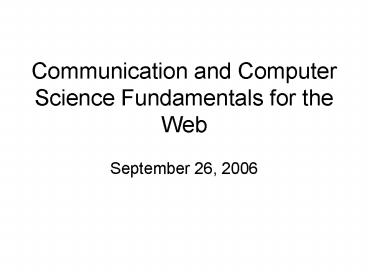Communication and Computer Science Fundamentals for the Web - PowerPoint PPT Presentation
1 / 19
Title:
Communication and Computer Science Fundamentals for the Web
Description:
http://www.vw.ca/vwca/models/0,,48,00.html (Group 6) User Characteristics. Age. Gender ... Class Notes. Parasocial Communication: ... – PowerPoint PPT presentation
Number of Views:35
Avg rating:3.0/5.0
Title: Communication and Computer Science Fundamentals for the Web
1
Communication and Computer Science Fundamentals
for the Web
- September 26, 2006
2
Usable Unusable Sites
- Several basic themes
- Performance
- Purpose Lazar calls this mission
- Quality and arrangement of information
- Up to date, clear, complete, accurate
- Navigation
- Layout, graphics, and colour
- Professionalism
- Images support basic mission and info
- Audience
- Personal likes and dislikes
- Not random
3
References Cited
- Microsoft
- Nielsen Norman Group
- Gajbhiye
- Asterisk
- NetMechanic
- WebReference
- Ezine
- IBM User-Centered Design/ Design
4
Now some communication theory to inform your
observations
5
Functions of Communication
- Inform
- Persuade
- Motivate
- These are also Mintzbergs functions of
management
6
Human Communication vs.Human-Computer Interaction
(HCI)
- Parasocial interaction
- Websites complex form of communication
- Textual Model Rhetorical model
- Graphics Model Kress and van Leeuwen
- Interactivity Sender-Receiver model
- Visual communication
- How this all ties back to usability
7
Parasocial Interaction (Horton Wohl, 1956)
- Media equation (Reeves Nass, 1996)
- Both theories note that people treat mass media
like real people and places - Develop relationships with websites
- Make the same kinds of judgments about
attractiveness, credibility, trustworthiness - Social psychology experiments rerun with
computers found the same results
8
Nature of Websites
- Combine features of
- Text ? Information
- Graphics ? Emotional Connections
- Function ? Interactivity
- Variety of principles developed for good writing
and good programming - In addition, need to recognize social bond
created between reader and site - unconscious
- powerful
9
Rhetorical Model (Aristotle)
- People are persuaded by texts (arguments) on
the basis of - Logos (logical nature of the argument reason)
- Ethos (character of the speaker ethics)
- Pathos (emotion created in the listener)
- A skillful writer creates appropriate arguments
based on knowledge of the audience and the
rhetorical situation
10
Models of Visual Communication
- Perceptual limits (from experimental psych)
- Aesthetics
- Model of Visual Rhetoric (Kress van Leeuwen)
- Perspective (realistic vs. subjective image)
- Vertical angle (power)
- Horizontal angle (involvement)
- Size of frame (social distance)
- Gaze (direct vs. indirect social address)
- Visuals create emotional connections (or not)
11
Sender-Receiver Model
- Shannon-Weaver model (1949)
- Identifies problems of transmission and
environment
12
What this means
- Web designer needs to be able to
- Articulate goals (mission)
- Gain a clear understanding of potential
audiences - Primary audiences
- Secondary audiences
- Gatekeeper audiences
- Watchdog audiences
- Design on the basis of the relationship desired w
target population
13
Lazars User-Centred Design Life Cycle
- Define Mission and Target Users
- Collect User Requirements
- Create and Modify Conceptual Design
- Create and Modify Physical Design
- Perform Usability Testing
- Implement and Market Site
- Evaluate and Improve Existing Site
- Return to Stage 1
14
User Analysis
- Identify salient features of the audiences for
- http//www.hummer.com/ (Group 1)
- http//www.smart.com (Group 2)
- http//www.lexus.com/ (Group 3)
- http//www.honda.ca/MotorcycleEng/default.htm
(Group 4) - http//www.rolls-roycemotorcars.com/ (Group 5)
- http//www.vw.ca/vwca/models/0,,48,00.html (Group
6)
15
User Characteristics
- Age
- Gender
- Purchasing power
- Attitude to technology
- Thrill-seeking behavior
- Interest in the environment
- Type of computer and connection
- Historical involvement with brand
16
Class Notes
- Parasocial Communication
- People make a first impression of a website
within fractions of a second - First impression hard to improve
- Possible to decrease credibility with a 2nd
impression - Issues of appearance, trustworthiness, etc. from
human communication apply to the web
17
Class Notes
- Rhetoric
- mere Rhetoric empty talk
- Rhetoric as the basis of persuasion in Western
culture different themes in Asian (especially
Confucian) culture - Ethos related to credibility of speaker
- Need to establish common places
- Audience expectations designer/ writer
presentation - Disappointment reflects back on the relationship
with the site
18
Class Notes
- Perceptual limits
- 5 /- 2 items can be remembered in short-term
memory - What goes into long-term memory must go into
short-term memory first - Memory performance can be improved by chunking
examples - Telephone numbers
- Headings in papers and reports
- Webpages in a website
19
Class Notes
- Next class
- Each group to look at its website
- Will have a few minutes before class to discuss
findings - Present short findings to class































